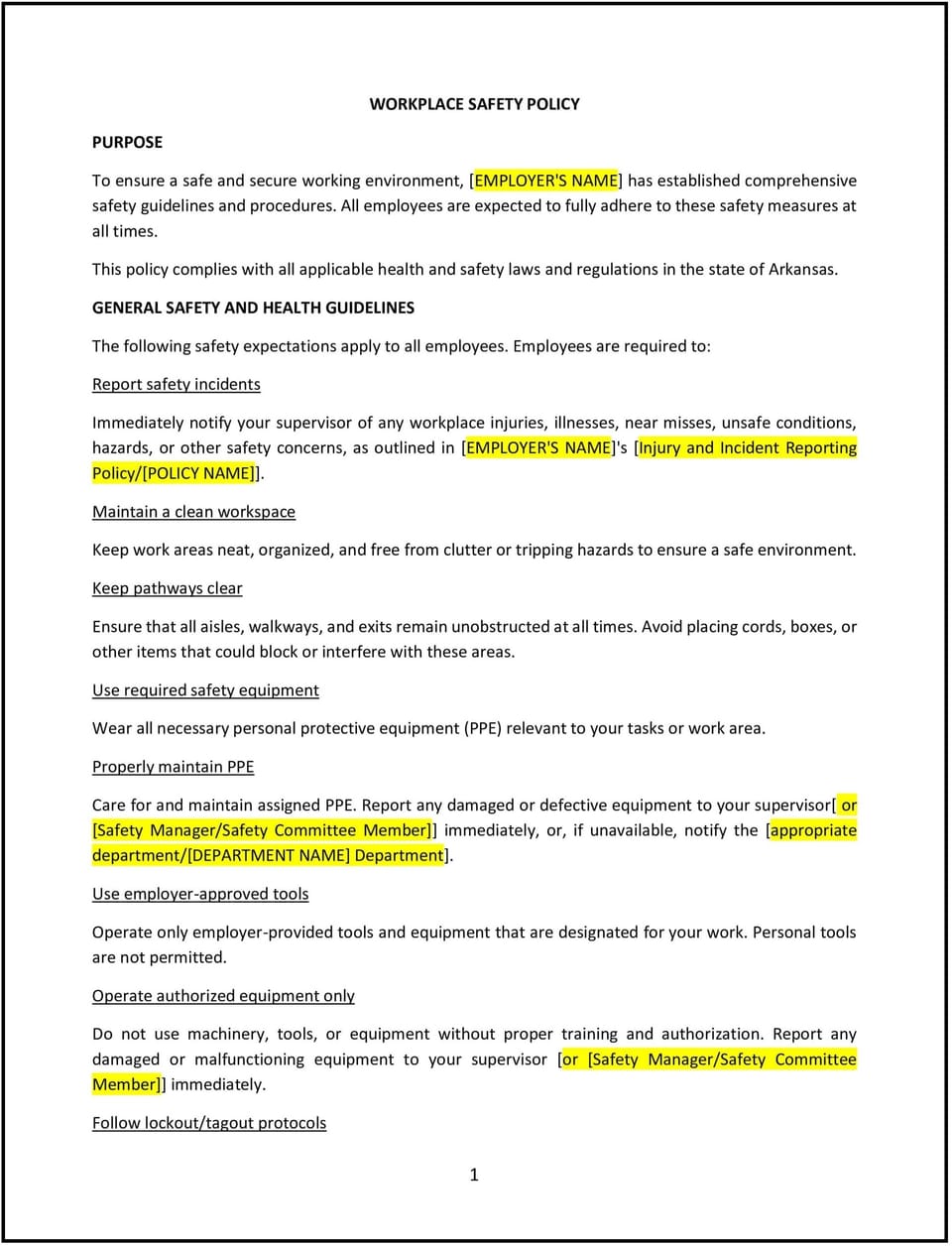Workplace safety policy (Arkansas): Free template

Workplace safety policy (Arkansas)
In Arkansas, a workplace safety policy provides businesses with guidelines to create and maintain a safe environment for employees, customers, and visitors. This policy outlines safety standards, reporting procedures, and preventive measures to minimize workplace accidents, injuries, and illnesses.
By implementing this policy, Arkansas businesses can promote a culture of safety, protect employee well-being, and comply with state and federal workplace safety regulations, including OSHA requirements.
How to use this workplace safety policy (Arkansas)
- Define safety responsibilities: Clearly outline the roles and responsibilities of employees, supervisors, and management in maintaining workplace safety.
- Establish reporting procedures: Provide employees with clear instructions for reporting hazards, accidents, or near-misses, including designated contacts and timelines.
- Communicate safety standards: Specify the safety protocols and practices employees must follow, such as wearing protective equipment or adhering to emergency procedures.
- Conduct training: Offer regular safety training to ensure employees are aware of risks and know how to prevent or respond to accidents.
- Monitor and evaluate: Regularly assess workplace conditions to identify and address potential hazards proactively.
Benefits of using this workplace safety policy (Arkansas)
This policy offers several advantages for Arkansas businesses:
- Promotes a safe workplace: Reduces risks of accidents and injuries, protecting employees and visitors.
- Supports compliance: Aligns with Arkansas workplace safety regulations and OSHA standards to ensure legal adherence.
- Enhances productivity: Minimizes disruptions caused by workplace incidents, maintaining operational efficiency.
- Builds trust: Demonstrates the business’s commitment to employee well-being, fostering a positive workplace culture.
- Encourages accountability: Establishes clear expectations and processes for addressing safety concerns effectively.
Tips for using this workplace safety policy (Arkansas)
- Address Arkansas-specific considerations: Reflect state regulations and industry-specific safety standards in the policy.
- Use safety tools: Implement tools like checklists, signage, or hazard identification systems to reinforce safety protocols.
- Involve employees: Encourage employees to participate in safety committees or initiatives to promote a shared sense of responsibility.
- Document incidents: Maintain thorough records of accidents, investigations, and corrective actions to ensure transparency and compliance.
- Update regularly: Revise the policy to reflect changes in laws, workplace conditions, or safety technologies.
Q: How does this policy benefit the business?
A: This policy ensures a safe work environment, supports compliance with Arkansas safety regulations, and reduces risks of accidents and legal liability.
Q: What safety protocols are included in this policy?
A: The policy covers practices such as hazard reporting, use of protective equipment, adherence to emergency procedures, and participation in safety training.
Q: How does this policy support compliance with Arkansas laws?
A: The policy aligns with OSHA standards and Arkansas-specific workplace safety regulations to promote lawful and effective safety practices.
Q: What steps should employees take to report a safety concern?
A: Employees should notify their supervisor or designated safety officer promptly, providing details of the hazard or incident and following the reporting procedures outlined in the policy.
Q: How can the business prevent workplace accidents and injuries?
A: The business can conduct regular safety training, perform risk assessments, enforce compliance with safety protocols, and address hazards proactively.
This article contains general legal information and does not contain legal advice. Cobrief is not a law firm or a substitute for an attorney or law firm. The law is complex and changes often. For legal advice, please ask a lawyer.


